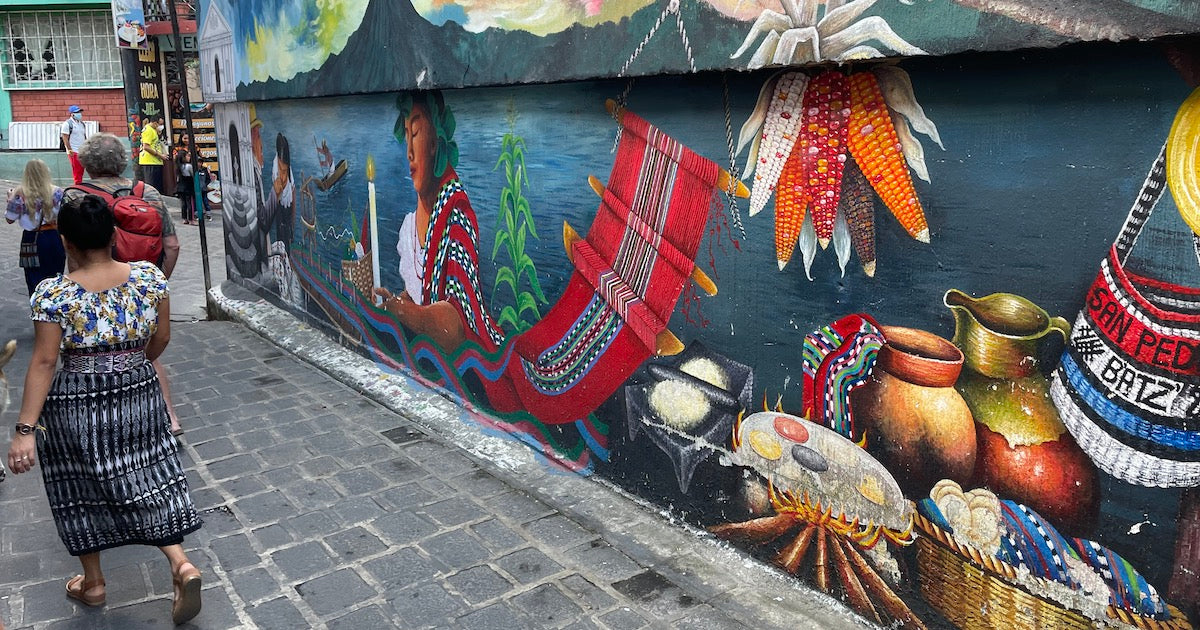What is a “huipil”?
A huipil (pronounced; ui · pil) is a form of “traje tradicional” or “traditional dress” worn by women in parts of Mexico and throughout Guatemala. The name comes from the Nahuatl word huīpīlli and its origins are as complex, storied, and symbolic as the Quetzalcoatl, a feathered serpent deity of Mayan lore.

The many indigenous cultures of Guatemala
Guatemala is home to 25 different indigenous groups and 24 different languages, 22 of which are of Mayan origins. Each hand-loomed huipil represents the unique history of each indigenous group through the artistry, colors, weaving pattern, and craftsmanship that have been passed down from generation to generation amongst these groups.

(Doña Nacha Ignacia hand looming using traditional naturally dyed "maguey" or agave fibers with Rising Minds NGO in San Pedro la Laguna, Lake Atitlan)
What are huipiles made from?
Huipiles are traditionally hand loomed on back strap looms using cotton, or agave fibers, a form of weaving that dates back to 2500 BC. Indigo, coffee, tree bark, seashells, and other natural materials were traditionally used to dye the fabric before looming. The Spanish introduced new fibers such as wool and silk. Now, polyester, rayon, and acrylic fibers are used. While most traje tradicional huipiles are still made using traditional practices, less expensive machine-made huipiles are starting to gain popularity in Guatemala. Whether handmade or machine-made, each one-of-a-kind huipil is a true textile artform that celebrates the colorful culture and historical significance of indigenous groups of the nation.

(Colorful hand loomed huipiles from the Xela, Quetzaltenango)
The many stories of huipiles
Each huipil has a story to tell… whether it represents the beauty of the sun reflecting off of a lake, like the huipiles of San Juan la Laguna, or to paint a picture of ethereal multicolored horses and birds like those of the Nebaj. Zig zag patterns can symbolize mountains, volcanoes, or the ups and downs of life, while animals, trees, and cosmic designs represent a large breadth of Mayan mythology, and carry different meanings depending on where they are woven.

Guatemalan and Mayan Color Symbolism
Guatemala is a colorful country, and those colors are reflected throughout the man-made and natural world. Rich hues are present in everything from art and architecture through the rich jungle canopies, dry deserts, luscious lakes, rugged coastlines, and mystical volcanoes of the nation. Each color has its own symbolic meaning:

Like the mythical Quetzalcoatl, colorful huipil fabrics are deeply symbolic of Mayan culture and history. This artform supports countless communities, families, indigenous groups and individuals while helping to keep ancient traditions alive. Did you know that these huipil fabrics are used to make more than huipiles? They are also make traje tradicional for indigenous men, hats, bags, and other accessories. In order to support this cultural artform and help bring it to the world, we have teamed up with leather artisans around Lake Atitlan in Guatemala who have turned these one of a kind textiles into beautiful leather huipil bags, huipil leather belts, and handmade dog collars.
Check out our line of huipil infused leather goods handmade by artisans in Lake Atitlan. The beautiful huipiles come from San Martín Jilotepeque, Chimaltenango, the Mam of Todos Santos, Huehuetenango, the Ixil of Nebaj, Quiché, and many other indigenous groups and communities around the country.
Each one of a kind Guatemalan huipil accessory is a usable piece of art… Which one will you get?



